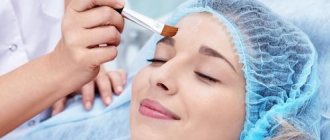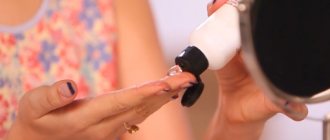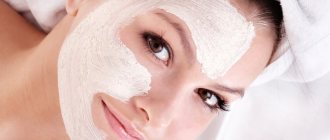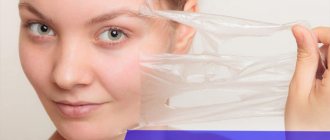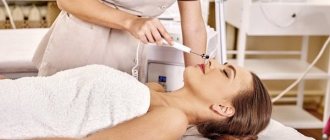Cosmetology for teenagers is a complex of cosmetic services aimed at restoring a healthy skin balance and getting rid of imperfections such as acne (pimples), blackheads and age spots (freckles). In adolescence, skin problems can cause complexes to appear, and taking care of the skin during this difficult period for the body can literally change your child’s life for the better. The Medial clinic offers a range of services for the treatment of problematic teenage skin:
- acne treatment for teenagers
- skin cleansing and superficial peelings
- laser removal of pigmentation - freckles
Features of teenage skin
It is impossible to unequivocally answer the question at what age teenagers can undergo facial cleansing, since changes in the body begin at different ages from 10 to 14 years. It is recommended to monitor the first manifestations of the transition period.
Most often, cleaning is done for teenagers from the age of 13-14, it is during this period that the active activity of the sebaceous glands begins. Skin changes under the influence of several factors:
- An excess of male sex hormones leads to excessive sebum secretion. Moreover, this process occurs at a faster rate than usual. Pores become clogged with excess sebum. The face of the forehead, nose, chin shines.
- Bacteria actively multiply in places where sebum accumulates. They penetrate deep into the pores and form purulent inflammation there.
- Errors in the daily care procedure. Teenagers often completely neglect cleansing the skin, and during periods of excessive activity of the sebaceous glands, it is necessary to include additional facial cleansing products (scrubs, masks).
- Young men in adolescence begin to grow facial hair, so they begin to shave, which injures the skin. Shaving is often contraindicated for problem skin.
Facial peeling is an effective method of cleansing and rejuvenating the skin.
Oily and combination facial skin, clogged pores (comedones), premature skin aging, peeling, enlarged pores, problematic skin, acne - all these problems require not only competent, high-quality skin care, but also effective cleansing.
Complete cleansing of facial skin, smoothing its relief, healing and rejuvenation - all these tasks are successfully performed by one of the most popular and sought-after procedures in cosmetology - facial peeling.
Facial peeling is a cosmetic procedure aimed at cleansing different layers of the skin of the face, using chemicals or hardware methods, and based on the skin’s ability to regenerate (i.e., natural restoration and renewal of skin cells).
The word “peeling” comes from the English “peeling”, which means peeling, flaking, cleaning.
During peeling, the skin gets rid of the layer of keratinized cells and the renewal of the deep layers of the dermis is activated, stimulating collagen production. The procedure allows you to eliminate or make many cosmetic defects less noticeable: small expression wrinkles, enlarged pores, acne, signs of photoaging and photodamage to the skin (freckles, age spots), scars and stretch marks.
Having tried once what peeling is from a good (!) specialist, many simply cannot refuse this procedure. After all, thanks to peeling, the dream becomes reality: we get rid of old cells, the skin becomes smooth, radiant, and a healthy complexion returns. There are several types of peeling , each skin type has its own option. Dead skin cells can be removed using mechanical, chemical or enzyme peels. If you know how a particular peel works, you can find the ideal facial peel for your skin type. Mechanical peeling During mechanical peeling, small grains contained in the peeling paste or gel erase skin cells. The more sensitive the skin, the smaller and rounder they should be. Sanding granules such as microcrystals or crushed olive pits have sharp edges and are only suitable for rough leather. Therefore, for mechanical peeling, round grains of synthetic origin or granules of jojoba wax are most often chosen. Mechanical peels are suitable for sensitive and thick skin. Mechanical peeling is contraindicated for acne or chronic dermatosis.
Chemical peeling The main active ingredient in this type of peeling is acid. Different types of acids are used - from exfoliates (for example, glycolic, lactic, ascorbic, fruit acids) to acids for medium and deep peeling (for example, different concentrations of trichloroacetic acid). This type of peel increases blood flow by chemically irritating the skin. Chemical peels irritate the skin in the right places, stimulating the intensive formation of new cells. The skin becomes smooth, pink and elastic. Chemical peels are suitable for normal to oily skin types, as well as acne-prone skin. Enzyme peeling Enzyme peelings act directly on dead skin cells, which can simply be washed off after the peeling. Enzymes are mainly obtained from fruits (for example, the enzyme papain is made from papaya). The advantage of enzyme peeling is that it is very gentle on the skin and acts particularly evenly. In this case, the blood supply to the skin is not stimulated. Important: Enzyme peels are suitable for sensitive, dry skin and acne-prone skin.
Types of peelings based on strength and depth of impact: • Superficial peeling - affects the upper layers of the skin and does not penetrate deeper. The procedure is considered quite safe, quick and does not require a special rehabilitation period. One visit to a specialist per week will be enough for the full effect.
• Medium chemical peeling affects the deeper cell layers and affects the deeper layers of the epidermis. Less traumatic than deep peeling, but more effective than superficial peeling. Solves problems such as fine wrinkles, pigmentation, small scars, acne marks. It can be performed not only on the face, but also in the neck, décolleté, and back of the hands. Conducted for people over 25 years of age. The recovery period after the procedure is about seven days. Over time, the crusts disappear, and for about fifteen days the skin may have a slightly red tint.
• Deep peeling . The most aggressive type of peeling. Level of exposure – all layers of skin. The surface of the skin is burned, its stratum corneum is lost. It is not recommended to do the procedure at a young age. Typically, mature people who have problems such as sagging skin, deep scars and post-acne marks, wrinkles, and severe skin pigmentation resort to the procedure. The procedure is quite painful and is performed using good local anesthesia. Within two weeks, the scabs will fall off and should not be peeled off on your own. Special care is required: the use of anti-inflammatory drugs, the application of a special drug.
Who is this procedure for? The procedure is universal and suitable for many women and men with any skin type, the main thing is to individually correctly select the required active ingredient and its concentration.
At a young age, peeling is carried out only if indicated. It is not recommended to carry out aggressive medium and deep peels.
But in adulthood, peelings have a beneficial effect, because... In addition to deep cleansing, the processes of regeneration, cell renewal, and collagen production are launched, which means a good rejuvenating and lifting effect occurs.
When is the best time to do it?
Peels are best carried out at a time when sun activity is minimal, i.e. during the period from October – April. But there are also exceptions.
PRX-T33 is a new generation peeling that cleanses and rejuvenates the skin. Its uniqueness is that it does not destroy the top layer of the skin and, therefore, does not require a significant rehabilitation period. The advantages of this procedure are that it is painless, is carried out quite quickly and can be done all year round.
During the procedure, the following occurs: • smoothing of the skin texture; • fight against pigmentation; • lifting effect; • deep hydration. Process of the procedure The specialist examines the current skin condition and selects the necessary peeling composition. Serums with Retinol are often used to prepare the skin. Anesthesia may be needed. The choice of peeling is the most important step in the procedure.
Before applying the composition, the skin is treated with a disinfectant so that the face is not covered with a fatty film. A complete facial peel can take from twenty minutes to an hour. Then the cosmetologist selects post-peeling care. Contraindications: • Inflammatory skin lesions. • Pregnancy and lactation period. • Allergy to the components of the drug. You should consult individually for the following problems: • Various skin growths. • Dilated vessels and capillaries. Chemical and other types of peelings are becoming more and more popular every year. The procedure will help solve the most basic skin problems. It is very important to trust a competent specialist and then the result will only be positive.
Peelings: price in Moscow.
Our prices do not exceed the average cost of peeling in Moscow. At the same time, our clinic’s specialists use only drugs certified in Russia from the world’s leading brands. This is a guarantee of the success of the procedure!
Sign up for a free consultation with a cosmetologist at the SOLA Clinic of Aesthetic Medicine and Cosmetology with digital skin diagnostics. With its help, you can accurately determine the condition of the skin and identify its problems.
Our specialists will conduct a detailed analysis of the data obtained and select the most suitable type of peeling for you, taking into account your individual characteristics and financial capabilities, or develop a personal program of procedures.
By combining peeling with other cosmetic procedures, you will achieve maximum results. This means delaying the manifestation of age-related changes for several years!
We recommend
- What types of acid peels are there? Which to choose?
How to care for teenage skin
Daily care should include the following steps:
- cleansing;
- toning;
- hydration;
- nutrition;
- treatment.
The first stage is the most important in all care, since the main part of the impurities (dust, sebum, dead cells) are removed with cleansers. For teenage skin, special products are created that regulate the functioning of the sebaceous glands. Depending on your skin type, you can choose gels and foams with neutral Ph, with the addition of herbal ingredients. After washing, toning products dry the skin and remove remaining dirt. Next, moisturizing or nourishing creams and gels are selected based on skin type. The time of year also matters a lot. Too oily cream in summer clogs pores and provokes the formation of comedones. The last step in daily care is the treatment of rashes and inflammations. This can be an antiseptic pencil, which is applied pointwise to inflamed areas. It is possible to use salicylic acid, which is used to wipe the entire face. Acid kills bacteria and regulates the functioning of the sebaceous glands.
In addition to daily procedures, 2-3 times a week it is necessary to use additional care - a soft scrub for deep cleansing of pores. Scrubs are contraindicated for dry skin, so you should opt for cleansing masks.
ATTENTION! The main thing you should not do in self-care is squeezing pimples. These manipulations can aggravate the problem. You can spread the infection with your hands, which will start a strong inflammatory process that will have to be treated under the supervision of a doctor.
Having a teenager’s face cleaned by a cosmetologist is another way to care for problem skin. Professional cleansing in a cosmetology salon is deeper and more thorough. Mechanical facial cleansing for teenagers is done once a month manually. A contraindication to the procedure is an active inflammatory process on the face.
Is it possible to do milk peeling yourself?
There are affordable ways to do milk peeling at home. To do this, you can purchase fermented milk products in the store or, even better, make them yourself. Also, all components of milk facial peeling can be purchased at the pharmacy.
The simplest methods that can be used daily include washing with milk. Another popular product is also used - kefir. It is applied to the desired area, left for 20 minutes and washed off with water. You can use yogurt, cream, sour cream in the same way. The main thing is that the product is completely natural, without impurities or additives. An example of a peeling mixture: 1 teaspoon of salt, 2 tablespoons of high-fat cream, 1 tablespoon of sour cream.
All of these products contain small amounts of the active ingredient, so you need to carefully monitor the time the product is on your face. If the skin is very sensitive and reacts to even a small percentage of the substance, it is better to use herbal cubes or completely abandon the procedure with lactic acid. When using kefir, you must remember that on dry skin you need to apply a fresh product with a high fat content, on oily skin - sour and low-fat.
What services do cosmetologists offer for teenagers?
The most effective, and therefore in demand, care procedure remains facial cleansing for teenagers. The procedure is carried out manually (mechanical), machine (ultrasonic) or a mixed method. Ultrasonic cleansing cleanses the upper layers of the skin and is used in the absence of serious problems. Manual cleaning allows you to clear the sebaceous ducts of accumulated fat, which creates plugs. After manual cleaning, deep cleansing of the pores is achieved.
Superficial peeling with fruit acids is also recommended for teenage skin. This procedure removes all surface impurities and dead skin cells. As a result, the pores and ducts open, making them easier to clean. Fruit acids regulate sebum production and help improve complexion.
The Darsonval procedure is also useful for adolescents. Microcurrents improve oxygen exchange in tissues and activate microcirculation.
For oily skin, Jacquet massage is sometimes prescribed. Its peculiarity is that the effect on the skin is made using talc. This product dries and absorbs excess fat.
Homemade peeling recipes with lactic acid
To prepare a cosmetic mixture at home, you need to take lactic acid and dilute it with water to the desired condition. If you need to make a lotion, it will be a 1% solution, for a mask you need 4%, 30% is used for milk peeling. A concentration above 40% will be too much for home use. You will also need medical alcohol, cotton pads and lotion containing lactic or fruit acid.
The face is cleansed with a mild tonic and degreased with alcohol. Peeling is applied with a disc, first left for about 2 minutes. If no negative reactions occur, the processing time is increased. Finally, be sure to wash your face with cool water.
The recipe for milk peeling with acid and yogurt is as follows: 50 milliliters of yogurt without additives is mixed with a tablespoon of ground oatmeal. Then 1 milliliter of lactic acid is injected, and the resulting composition is applied to the desired area. After 20 minutes, wash with cold water.
It is important to understand that such procedures at home will help get rid of minor problems - make your complexion healthier, and allow you to get rid of shallow wrinkles. But you shouldn't expect drastic changes.
How to clean
The patient sits in a cosmetology chair. Teen facial cleansing begins with a cleansing procedure. A cosmetologist uses professional cosmetics that have a healing effect. To open access to the sebaceous ducts, it is necessary to expand the pores. This is done using a steam bath. For this purpose, there is a device in the cosmetologist’s office - a vaporizer. To soften the accumulation of sebum, the specialist performs manipulations using warming agents. After this, the specialist manually squeezes out the sebum. The procedure can be performed using fingers and a napkin, or using additional tools: an UNO spoon (metal loop) to remove particularly deep impurities in the pores and a Vidal needle to soften and pick up comedones. At the end of the cleansing procedure, the skin is treated with an antiseptic lotion. The procedure ends with applying a soothing cooling cream or mask to the skin. Completing the procedure with a mask allows you to tighten the pores, remove burning sensations and irritation on the skin. The total duration of the procedure is 90 minutes.
Basic recommendations after the procedure
Facial cleansing during adolescence can achieve impressive results. After the procedure, the skin acquires an even texture, as the pores are cleaned and tightened. It is worth considering that after the procedure you must follow a number of recommendations to avoid complications:
- For 1 day, it is forbidden to touch your face with your hands so as not to introduce pathogenic bacteria;
- After the procedure, the cleansed sebaceous glands are activated and begin to produce sebum at an even faster rate. In the first day, the skin of the face is constantly shiny; excess fat can be removed with the help of chlorhixedine. Blot your face with a napkin soaked in the product, but not more than 3 times a day;
- The first wash can be done 12 hours after cleansing. It is forbidden to wash with soap or running water. It is best to wipe your face with an alcohol-free tonic or herbal decoction;
- In the first two days, the use of any decorative cosmetics, including tinting eyebrows and eyelashes, is prohibited;
- Cleaning is a traumatic procedure. The skin needs a period of rest to restore natural processes. For 7–10 days after cleansing, it is prohibited to use scrubs and masks with coarse abrasive particles. As an additional means for cleansing pores, it is permissible to use rollers during this period;
- If possible, in the first 3 days you should limit your time on the street;
- For 1 week after cleaning, it is forbidden to visit the solarium, sunbathe, go to the bathhouse, or engage in active physical activity;
- To moisturize the skin, it is recommended to use gels, emulsions, and serums. Fatty, dense creams provoke the formation of comedones;
- If an area of skin is injured during cleaning, a crust will form. You can't tear it off. You need to wait until it dries completely and then falls off on its own. If you tear off the crust with your hands, a pigment spot will form in its place.
How does the procedure work?
The peeling process occurs in several stages.
- Preparatory activities. No lengthy, thorough preparation is required before the manipulation. You need to avoid sunbathing for two weeks and use sunscreen cosmetics. If you have herpes, undergo antiviral therapy.
In some cases, preparation will be necessary if the client’s skin condition requires it. In this case, a couple of weeks before the procedure, every day before bed, the skin is treated with a product with one or two percent lactic acid or a product with a small content of fruit acids.
- Makeup removal, skin cleansing. At this stage, products are used that cleanse the face and remove all impurities. This way the skin is prepared for further work.
- Toning. Here a tonic with fruit or lactic acids is used.
- Pre-peeling. At this stage, the cosmetologist applies a special preparation containing an active substance to the affected area. This is to ensure that it penetrates the skin and is distributed properly. Such manipulations allow you to additionally check whether allergies will occur. If such preparation is excluded from the process, it is necessary to use a minimum of the active ingredient when applying milk peeling mousse or gel so that the client’s reaction to the activity of the substance can be monitored.
- The use of lactic acid itself. Using special devices, the specialist coats the skin with an active substance that contains 30–90% acid. This is done in the following order: frontal part, temples, side cheeks, décolleté, front of the neck, chin, skin around the lips, nose, area around the eyes. Everything happens within 20 minutes, while the cosmetologist observes the client’s reaction. If any problems suddenly appear, the manipulation is stopped and the peeling is neutralized.
According to the standard, when performing milk peeling for the first time, it is better to use the active substance to a minimum. After application, you should wait a while. If an allergic reaction does not occur, the concentration and duration of exposure can be increased. The dose of the substance and the time of manipulation are calculated by the cosmetologist based on an assessment of the client’s skin.
- Neutralization of peeling. A special preparation is applied to the peeling area in the following direction: from skin areas with less sensitivity to areas with greater sensitivity. Then wash your face with strictly cool water (the acid reacts to warm or hot temperatures and irritation may occur). In the final stage, the treated area is blotted with a towel.
- Skin treatment to soothe and hydrate. After completing the neutralization stage, a moisturizing mask is applied (this could be, for example, an alginate mask with brown algae, it has a cooling effect, in this case no rinsing is required). Then a cream with a nourishing and moisturizing effect is applied.
- Further skin care at home. After the procedure, the following reactions often occur. The skin may peel a little over the course of several days. It happens that mild redness occurs, which stops fairly quickly. It is extremely rare that peeling causes a burn. As a rule, this happens due to insufficiently qualified actions of the cosmetologist or an unsuitable drug. The specialist must monitor whether the client has an allergic reaction to the product used. The problem can be solved with the help of Olazol or Panthenol. You also need to follow certain recommendations:
- You should avoid aggressive cleansers for one day;
- do not epilate treated areas;
- do not scratch or touch the treated areas of the face and body;
- provide skin protection from the sun;
- the next day after peeling, do not use cosmetics.
Many of those who have undergone the procedure note that the effect is noticeable after the first use. But to improve and consolidate the result, you need to complete the course completely. As a rule, these are four or five procedures, after which the face will truly be transformed. How often is milk peeling done? If necessary, the course is repeated after six months. The service does not belong to the budget category - for one manipulation you will need to pay 1-5 thousand rubles.
We recommend
How to get rid of unwanted hair quickly, painlessly and permanently Read more
Contraindications
Any types of cleansing are contraindicated for adolescents with bronchial asthma, psoriasis, or allergic reactions. The procedure should be abandoned if there are open wounds on the skin, suppuration, or inflammation in the active phase. Mechanical cleaning is not recommended for people with dry sensitive skin. Ultrasonic cleaning is contraindicated for children under 12 years of age. The presence of rosacea and spider veins on the face also complicates the procedure. In addition, during the period of viral diseases, it is also prohibited to carry out any types of cleaning.
Video: Facial cleansing. Cosmetic procedure for a teenage girl
Conclusion
Teenage skin needs special attention. High-quality daily facial cleansing in the morning and evening comes to the fore. At the same time, it is necessary to have your face cleaned by a cosmetologist on an ongoing basis approximately once a month. In particularly advanced cases, the procedure may be prescribed more often. Metabolic processes in the body of a teenager occur much faster than in an adult, so you need to constantly monitor the condition of your skin. The less often professional cleaning is carried out, the larger the comedones become, the longer and more painful the procedure is, and accordingly, rehabilitation will also take more time.

